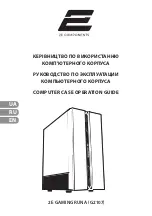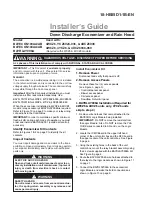
Appendix C. EasyFlux
®
DL CR6KH20
C-12
C.4 Operation
Operating
EasyFlux DL CR6KH20
requires the user to enter or edit certain
constants and input variables unique to the program or site. Constants are
typically edited only once when first initializing the program, whereas site-
specific variables are edited upon initial deployment and periodically as site
conditions change; for example, canopy height is a variable that may need to be
adjusted throughout a growing season. Appendix
CRBasic Editor and Load Program
(p. C-12)
, provides instructions on setting
constants, and Appendix
Enter Site-Specific Variables with Data Logger
(p. C-14)
, provides details on setting variables.
C.4.1 Set Constants in
CRBasic Editor
and Load Program
Before operating the station, the values for configuration constants should be
verified in the program code using
CRBasic Editor.
Open the program in
CRBasic Editor
. After the introductory comments at the
top is a section titled “USER-DEFINED CONFIGURATION CONSTANTS”
). Review the constants in this section and modify as needed.
If having difficulty locating the correct lines of code, search the program for
the word “unique”. This will locate all lines of code containing constants that
need to be verified. Look for the text comments on the right side of each line of
code for more explanation of the constant. Generally, the constants fall into
four categories:
1.
Program Function Constants
These are constants that determine the timing of code execution,
frequency of writing to output tables, memory allocation, etc. In most
cases, the default constants for these values may be retained.
A program function constant worth mentioning is
ONE_FULL_TABLE
. If this is set to
TRUE
, all of the intermediate
and auxiliary measurements will be included as data fields in the
main
FLUX_CSFormat
output table, rather than being in a separate
output table called
FLUX_NOTES
. For more information, see
(p. C-19)
2.
Sensor Selection Constants
All sensor selection constants begin with the prefix
SENSOR
. The
value is set to
TRUE
in the constant table if the system includes the
sensor. For example, if a system has a fine-wire thermocouple, the
constant
SENSOR_FW
should be set to
TRUE
. When set to
TRUE
,
the wiring in TABLE
will apply to the sensor and the data from
that sensor will be included in the data output tables.
If a sensor is not used, ensure the constant is set to
FALSE
.
3.
Sensor Quantity Constants
The value for these constants indicates the number of each type of
sensor in the system. For example, if three soil heat flux (SHF) plates
were being used, the constant
NMBR_SHF
would be set to
3
.
4.
Sensor Calibration Constants
Some sensors have unique parameters for their measurement
















































